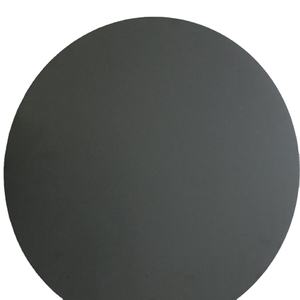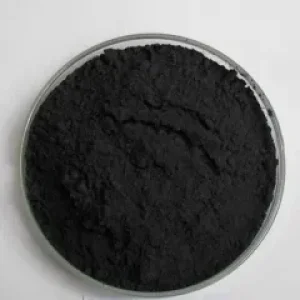Overview of Vacuum Hot Press furnace Boron carbide (B4C) high temperature vacuum furnace
Boron Carbide (B4C) is a ceramic compound renowned for its exceptional hardness and wear resistance, ranking just below diamond and cubic boron nitride in terms of hardness. Composed of boron and carbon atoms arranged in a covalently bonded crystal structure, it exhibits unique physical and chemical properties that make it highly valuable in various industrial and military applications. Boron carbide’s high melting point, low density, neutron-absorbing capability, and extreme toughness further distinguish it among advanced materials.
Features of Vacuum Hot Press furnace Boron carbide (B4C) high temperature vacuum furnace
-
Extreme Hardness: With a Mohs hardness of around 9.3 to 9.5, boron carbide is one of the hardest materials known, surpassed only by diamond and cubic boron nitride.
-
Lightweight: Despite its hardness, boron carbide has a relatively low density of about 2.52 g/cm³, which makes it an attractive material for lightweight armor systems.
-
Thermal Stability: It possesses excellent thermal stability, maintaining its properties up to temperatures around 2,000°C, making it suitable for high-temperature applications.
-
Neutron Absorption: Boron carbide is a potent neutron absorber due to its boron content, making it ideal for nuclear shielding and control rods.
-
Chemical Resistance: Resistant to most acids and alkalis, except for hydrofluoric acid and hot concentrated alkaline solutions, ensuring durability in corrosive environments.
-
Abrasion Resistance: Its exceptional wear resistance makes it suitable for applications where friction and abrasion are prevalent, such as sandblasting nozzles.

(Vacuum Hot Press furnace Boron carbide (B4C) high temperature vacuum furnace)
Parameters of Vacuum Hot Press furnace Boron carbide (B4C) high temperature vacuum furnace
1. Pressure: The pressure of the hot press furnace should be adjusted according to the specific requirements of the product being processed. A higher pressure can increase the heat dissipation efficiency, while a lower pressure can lead to faster formation of defects in the finished product.
2. Temperature: The temperature range for the high temperature vacuum furnace should be set accordingly to ensure proper functioning of the equipment and minimize damage to the product during the processing process.
3. Cycle Time: The cycle time for the high temperature vacuum furnace should be set appropriately to maintain consistent output at high temperatures. A longer cycle time may result in lower heat dissipation efficiency, while a shorter cycle time may allow for better product quality.
4. Extruder Speed: The extruder speed should also be set appropriately to achieve optimal production results. A high speed will cause more hot air to flow through the extruder, resulting in faster heat dissipation efficiency and improved product quality.
5. Functioning Checks: Before starting any operation, it is recommended to conduct functional checks to ensure that all system components are working correctly. This includes checking the hot press furnace’s operating parameters, inspecting the extruder for proper operation, and verifying that the, temperature, cycle time, and extruder speed are set according to the specifications provided by the manufacturer.
By following these parameters, it is possible to build a hightemperature vacuum furnace that meets the specific needs of the product being processed.

(Vacuum Hot Press furnace Boron carbide (B4C) high temperature vacuum furnace)
Applications of Vacuum Hot Press furnace Boron carbide (B4C) high temperature vacuum furnace
-
Armor Systems: Widely used in body armor, vehicle armor, and bulletproof vests due to its lightweight and superior protection capabilities.
-
Nuclear Applications: As control rods and shielding material in nuclear reactors because of its neutron absorbing properties.
-
Abrasive and Cutting Tools: In grinding wheels, polishing powders, and cutting tools due to its hardness and wear resistance.
-
Industrial Nozzles: For sandblasting and water jet cutting applications where resistance to wear and erosion is critical.
-
Military and Defense: As a component in armor-piercing projectiles and defensive systems.
Company Profile
MyCarbides is a trusted global chemical material supplier & manufacturer with over 12-year-experience in providing super high-quality carbides and relative products.
The company has a professional technical department and Quality Supervision Department, a well-equipped laboratory, and equipped with advanced testing equipment and after-sales customer service center.
If you are looking for high-quality carbide materials and relative products, please feel free to contact us or click on the needed products to send an inquiry.
Payment Methods
L/C, T/T, Western Union, Paypal, Credit Card etc.
Shipment
It could be shipped by sea, by air, or by reveal ASAP as soon as repayment receipt.
FAQs of Vacuum Hot Press furnace Boron carbide (B4C) high temperature vacuum furnace
Q: Is Vacuum Hot Press furnace Boron carbide (B4C) high temperature vacuum furnace toxic?
A: Pure boron carbide is generally considered safe to handle. However, during machining or grinding, dust inhalation can be a concern, requiring proper ventilation and protective equipment.
Q: Can Vacuum Hot Press furnace Boron carbide (B4C) high temperature vacuum furnace be machined?
A: Due to its extreme hardness, machining boron carbide is difficult and requires specialized techniques and diamond tooling. Grinding, EDM (Electrical Discharge Machining), or laser cutting are common methods.
Q: How does Vacuum Hot Press furnace Boron carbide (B4C) high temperature vacuum furnace compare to tungsten carbide in terms of hardness?
A: Vacuum Hot Press furnace Boron carbide (B4C) high temperature vacuum furnace is harder than tungsten carbide, with a Mohs hardness of around 9.3 to 9.5 compared to tungsten carbide’s 8.5 to 9.
Q: What is the primary use of Vacuum Hot Press furnace Boron carbide (B4C) high temperature vacuum furnace in the military sector?
A: Vacuum Hot Press furnace Boron carbide (B4C) high temperature vacuum furnace is primarily used in the military for body armor, armored vehicles, and as a component in armor-piercing ammunition due to its combination of hardness, light weight, and ballistic performance.
Q: Can Vacuum Hot Press furnace Boron carbide (B4C) high temperature vacuum furnace be used in high-temperature applications?
A: Yes, Vacuum Hot Press furnace Boron carbide (B4C) high temperature vacuum furnace maintains its structural integrity and properties up to very high temperatures, making it suitable for use in extreme heat environments such as furnace linings and high-temperature ceramics.

(Vacuum Hot Press furnace Boron carbide (B4C) high temperature vacuum furnace)





